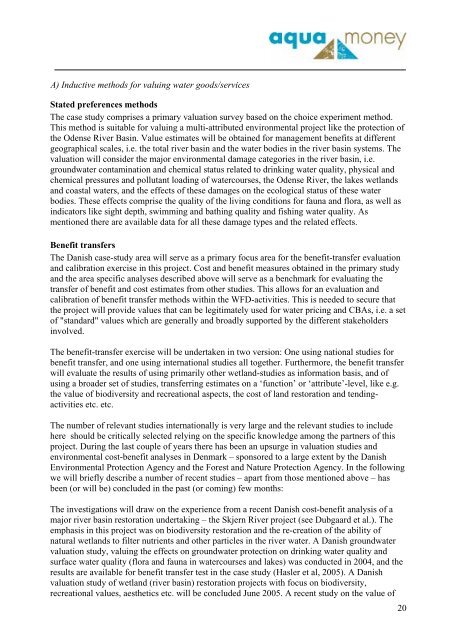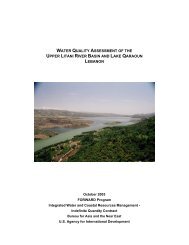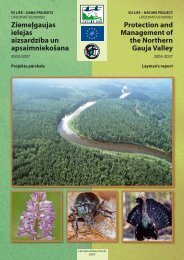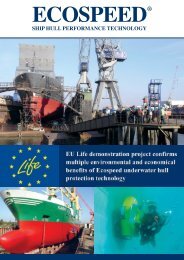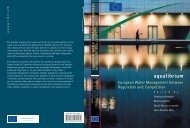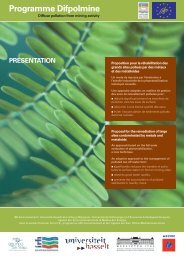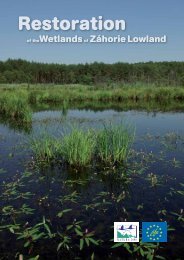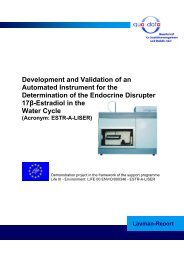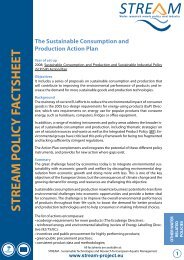case study status report odense river basin, denmark - wise-rtd.info
case study status report odense river basin, denmark - wise-rtd.info
case study status report odense river basin, denmark - wise-rtd.info
Create successful ePaper yourself
Turn your PDF publications into a flip-book with our unique Google optimized e-Paper software.
A) Inductive methods for valuing water goods/servicesStated preferences methodsThe <strong>case</strong> <strong>study</strong> comprises a primary valuation survey based on the choice experiment method.This method is suitable for valuing a multi-attributed environmental project like the protection ofthe Odense River Basin. Value estimates will be obtained for management benefits at differentgeographical scales, i.e. the total <strong>river</strong> <strong>basin</strong> and the water bodies in the <strong>river</strong> <strong>basin</strong> systems. Thevaluation will consider the major environmental damage categories in the <strong>river</strong> <strong>basin</strong>, i.e.groundwater contamination and chemical <strong>status</strong> related to drinking water quality, physical andchemical pressures and pollutant loading of watercourses, the Odense River, the lakes wetlandsand coastal waters, and the effects of these damages on the ecological <strong>status</strong> of these waterbodies. These effects comprise the quality of the living conditions for fauna and flora, as well asindicators like sight depth, swimming and bathing quality and fishing water quality. Asmentioned there are available data for all these damage types and the related effects.Benefit transfersThe Danish <strong>case</strong>-<strong>study</strong> area will serve as a primary focus area for the benefit-transfer evaluationand calibration exercise in this project. Cost and benefit measures obtained in the primary <strong>study</strong>and the area specific analyses described above will serve as a benchmark for evaluating thetransfer of benefit and cost estimates from other studies. This allows for an evaluation andcalibration of benefit transfer methods within the WFD-activities. This is needed to secure thatthe project will provide values that can be legitimately used for water pricing and CBAs, i.e. a setof "standard" values which are generally and broadly supported by the different stakeholdersinvolved.The benefit-transfer exercise will be undertaken in two version: One using national studies forbenefit transfer, and one using international studies all together. Furthermore, the benefit transferwill evaluate the results of using primarily other wetland-studies as <strong>info</strong>rmation basis, and ofusing a broader set of studies, transferring estimates on a ‘function’ or ‘attribute’-level, like e.g.the value of biodiversity and recreational aspects, the cost of land restoration and tendingactivitiesetc. etc.The number of relevant studies internationally is very large and the relevant studies to includehere should be critically selected relying on the specific knowledge among the partners of thisproject. During the last couple of years there has been an upsurge in valuation studies andenvironmental cost-benefit analyses in Denmark – sponsored to a large extent by the DanishEnvironmental Protection Agency and the Forest and Nature Protection Agency. In the followingwe will briefly describe a number of recent studies – apart from those mentioned above – hasbeen (or will be) concluded in the past (or coming) few months:The investigations will draw on the experience from a recent Danish cost-benefit analysis of amajor <strong>river</strong> <strong>basin</strong> restoration undertaking – the Skjern River project (see Dubgaard et al.). Theemphasis in this project was on biodiversity restoration and the re-creation of the ability ofnatural wetlands to filter nutrients and other particles in the <strong>river</strong> water. A Danish groundwatervaluation <strong>study</strong>, valuing the effects on groundwater protection on drinking water quality andsurface water quality (flora and fauna in watercourses and lakes) was conducted in 2004, and theresults are available for benefit transfer test in the <strong>case</strong> <strong>study</strong> (Hasler et al, 2005). A Danishvaluation <strong>study</strong> of wetland (<strong>river</strong> <strong>basin</strong>) restoration projects with focus on biodiversity,recreational values, aesthetics etc. will be concluded June 2005. A recent <strong>study</strong> on the value of20


